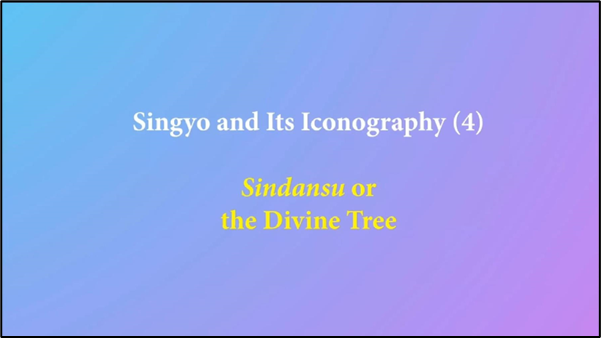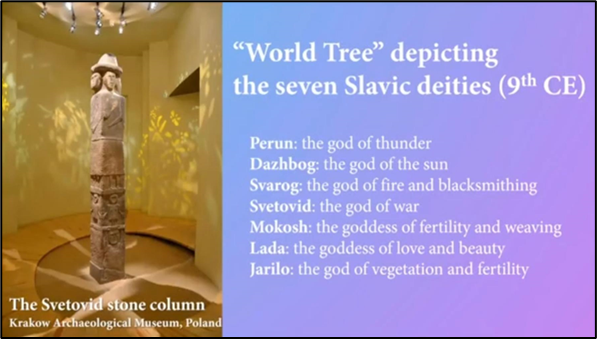SINGYO: THE SPIRIT TEACHINGS (part-4)
SINGYO: THE SPIRIT TEACHINGS (part-4)
After the Big Dipper and the importance of number seven, the next iconography of Singyo that I'll be discussing with you all will be:
Singyo and its iconographies - 'Sindansu or the Divine Tree'.🌳
SINDANSU can also be interpreted as the tree of life or the World Tree. There are also many other terms representing Sindansu.
"World Tree" depicting the seven Slavic Deities (9th CE)
⚡ Perun: the God of thunder
🌞 Dazhbog: the God of the Sun
🔥 Svarog: the God of fire and blacksmithing
💣 Svetovid: the God of War
👼 Mokosh: the Goddess of fertility and weaving
💕 Lada: the Goddess of love and beauty
🍀 Jarilo: the God of Vegetation and fertility
So, now we are looking at the Svetovid stone column (present in the Krakow Archaeological Museum, Poland). We can see that this is the same kind of column that we can find in the book. This is very commonly found in the Slavic nations, like Poland, Ukraine, Russia and so on.
The "World Tree" depicting the seven Slavic deities is known as the stone column of Svetovid, a kind of Sindansu or a divine tree. Svetovid means a world seer, a seer who sees the world, who is clairvoyant and able to see all the affairs in the world. The Svetovid also refers to a group of seven gods in the Slavic paganism and Slavic pantheon, that includes five gods and two goddesses. They are Perun, Dazhbog, Svarog, Svetovid, Mokosh, Lada and Jarilo.
"World tree" depicting the seven Slavic deities 9th CE
This is the illustration of the four different faces of the stone column of Svetovid. As you can see, there are three different tiers or three different parts of the stone column. The three tiers of the stone column represent the three levels of the world, from the bottom underworld, to the middle mortal world and the uppermost, largest, world of heavenly gods.When we take a look at the upper part of the column, the two goddesses and two gods are depicted. In the middle layer of the stone column, there are four people or two human females and two human males. It depicts the world of humans. Now the bottom layer of the column describes three gods who are now upholding and maintaining the world . So we learn there are also seven major gods in Slavic pantheon.
Now we are going to talk about the Obelisk, a symbol of connection between Egyptian pharaohs and the sun god ‘Ra.’
Obelisk, a symbol of connection between pharaohs and the Sun God 'Ra'
So this obelisk can be seen as a kind of Sindansu or divine tree because the ancient Egyptian pharaohs established this Obelisk as part of their efforts to ensure their immortality, their eternal life in their afterlife. So, in the ancient Egyptian religion the Pharaoh is believed to be a divine being who had to undergo a series of rituals and challenges in order to successfully reach the world of gods and become one with those gods. This Obelisk was seen as a symbol of the pharaoh's connection with Sun God “Ra”, who was believed to be the the ultimate source of life, energy, and power in the ancient Egyptian religion. So, by erecting this Obelisk, the Egyptian pharaoh aspired to receive the life energy of the Sun God Ra as he wanted to ensure his immortality after his death.Yggdrasil, the tree of life in Norse mythology
Yggdrasil is a central symbol in Norse mythology and is believed to be the axis around which the universe revolves. It is a massive ash tree that connects the nine world of Norse cosmology.Yggdrasil is one of the examples of the divine tree, world tree or tree of life that appears very often in Norse folklore. You must be very familiar with the yggdrasil through the Hollywood movies like Thor.
There are nine different worlds in Norse cosmology and each world is hanging on a branch of this Yggdrasil tree. One of the interesting points of this Yggdrasil is that there are three goddesses as well. When you look at the bottom, under the tree, there are three goddesses. They are wearing robes that look like those of nuns and these goddesses are called the Norns. These goddesses are believed to spin the threads of life which are woven into the fabric of destiny. These three goddesses are also believed to control the lengths of lifespan of each individual, determining the moment of their birth and manner of their death. There is also the Well of Urd. The Well of Urd is where these three goddesses meet everyday and discuss the lifespan of human individuals and the fate of the world.
And the rest of the pictures are depicting the sotdae, various forms of Sotdae. Sotdae is a symbol of the divine tree. The Sotdae in the center is made of stone. This was made in the 17th century and remained to this day. There are many artisans in Korea who really love making Sotdae. So, they make Sotdae with wood and give it to their relatives and family members as a gift because Sotdae is considered as a very sacred thing, as a very lucky charm, because from the ancient times it is considered as a symbol of connecting heaven and people. And also, there is clear evidence of this divine tree being the central place for the people in ancient times for getting together. This is an account from Samguk Yusa, from the 'Gojoseon chapter'. It says, "Hwanung let 3000 people down to the foot of the Divine Tree on the summit of Mt. Taebaeksan. He named this place 'Sinsi', the Divine City." So it says, Hwanung, the leader, along with his 3000 people, established their new nation in the foot of the Divine Tree on the summit of the mountain. So, it is seen that in ancient times, Korean people offered heavenly rituals towards the Gods and spirits of heaven and earth and they offered these rituals at the Sindansu tree, as it was a symbol of connection between heaven and earth. So, the Sindansu tree used to be a sacred place, a sacred sanctuary, where people went to meditate, pray and learn the teachings of Singyo.
This was all about SINDANSU or the Divine Tree. In my next and last article, I will mention about ALTARS AND PYRAMIDS.
Reference:
HACD lecture: Season 2, lecture 6
Singyo, the Spirit Teaching
INSTAGRAM:
HACD English - https://www.instagram.com/hacd.official/
HACD Korean - https://www.instagram.com/hansadan.official/
YOUTUBE:
HACD YouTube - m.youtube.com/@hansadan










댓글
댓글 쓰기